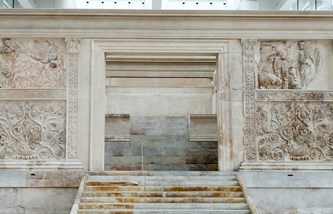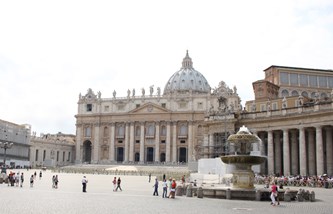Tours
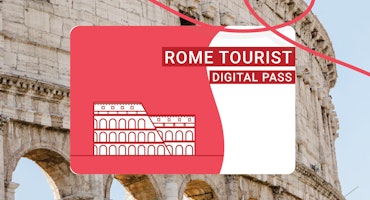
Rome Tourist Card
Rome Tourist Card
Snap up the Rome Tourist Card and you'll get everything you need to explore Rome's top highlights including Colosseum, Palatine Hill, Roman Forum and Hop on/off bus. You can even choose the order you see things in.
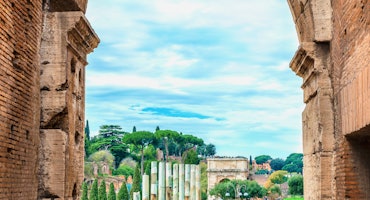
Colosseum, Roman Forum & Palatine Hill: Priority Entrance
Colosseum, Roman Forum & Palatine Hill: Priority Entrance
Skip the long lines at the Colosseum with this priority-entrance ticket. This ticket will let you bypass the crowds. And after exploring the Colosseum you can head to the area of the Roman Forum and the Palatine Hill.
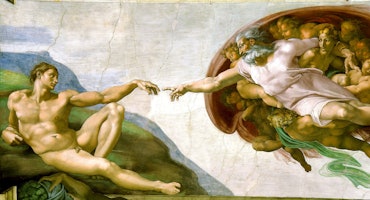
Vatican Museums & Sistine Chapel: Skip The Line
Vatican Museums & Sistine Chapel: Skip The Line
This ticket will make you save stress and time by allowing you to get priority entrance and skip the line. Visit the the countless masterpieces by Michelangelo, Raphael, Caravaggio, Tiziano and the Sistine chapel.
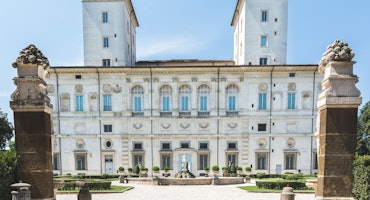
Borghese Gallery: Fast Track
Borghese Gallery: Fast Track
Galleria Borghese is located in the villa of the park Villa Borghese. Admire the architecture and furnishings of this beautiful villa. It is a museum full of art from the Renaissance. The collection includes several sculptures and paintings. Because of limited capacity get tickets for this museum weeks in advance.
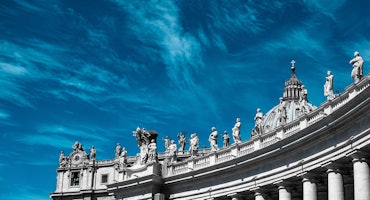
St. Peter’s Basilica: Dome Climb with Guide
St. Peter’s Basilica: Dome Climb with Guide
Get the most out of your visit to St. Peters with a guided tour to climb the basilica’s dome designed by Michelangelo and admire one of the stunning view. After the tour, you can explore the the basilica at your own pace.
Castel Sant’Angelo
With more than a million visitors each year, Castel Sant’Angelo (also known as Mole Adriana) is one of the main landmarks in Rome. Surrounded by massive walls, the central structure has a peculiar circular shape, which stand 48 meters above the ground. The site has undergone an incredible number of changes and structural alterations: from monumental burial site to fortress, from horrific prison to splendid private residence, from military headquarters to world famous museum.
This very special castle, just a stroll away from the Vatican, doesn’t have the gloomy and grim looks of the Medieval fortresses, but, as we will see, its mighty walls, halls decorated with frescoes and grids of passages, do hide more than one secret. A visit to this site, is not just a travel back in time, but an exciting travel through time, from 2000 years ago, up to the present day.
A Mausoleum for the Emperor Hadrian
The story begins around 130 A.D. when the emperor Hadrian, who wasn’t only greatly fascinated by art and philosophy, but highly regarded the spiritual world, decided to build a monument that would have served as the burial site for him, his family and his successors. As inspiration, he used the mausoleum of Augustus. The monument had a square plant, and was built with precious marbles and decorated with statues. At the top, it was surmounted by a huge shiny bronze statue of Hadrian riding a quadriga (a four-horse chariot).

The mausoleum was located in the suburbs of the city, on the other side of the Tiber river banks, where the Forum and the other important buildings stood. For this reason, a bridge was built to connect the site to the rest of the city. The construction works took some years, and were only completed by the successor of Hadrian, Antonino Pio, in 139 AD. Hadrian was finally buried here, together with his beloved wife Sabine. Among the emperors that were laid to rest here, there are Antonino Pio, Commodo, Marcus Aurelius and Caracalla, together with most of their wives and sons.
Hadrian's dream became reality, and the emperors, which were adored as deities after their death, would have had a proper burial. But, when reading the verses that Hadrian dedicated to his own soul, and engraved on a plaque in the imperial urns hall, we discover a much more intimate dimension to his feelings and fears about his inevitable passing away.
“Animula vagula blandula, Hospes comesque corporis, Quae nunc abibis? In Loca, Pallidula rigida nudula, nec ut soles dabis Iocos.” "Little soul, you charming little wanderer, my body’s guest and partner, where are you off to now? Somewhere without color, savage and bare; You’ll crack no more of your jokes once you’re there.” (Hadrian)
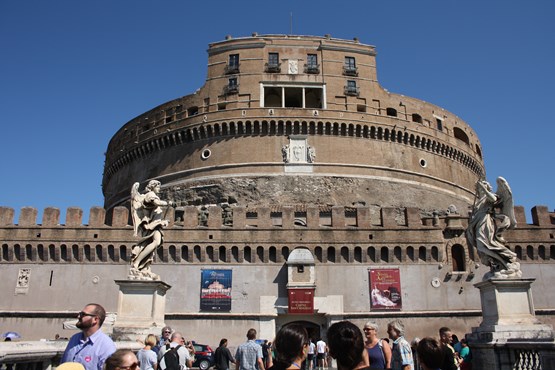
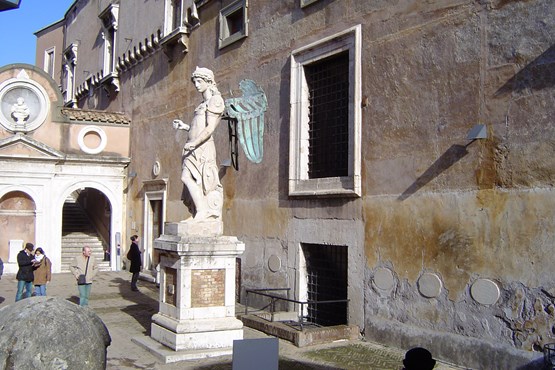
The Fortress, the Vatican and the Passetto
In 400 AD, the emperor Onorio decided to convert the castle into a fortress, to protect the city from the increasing raids of the Barbarians. The structure was incorporated into the Aurelian walls and fitted with turrets and bastions.
During the siege of the Vandals, the Romans finished all the ammunition, and started to throw to their opponents any heavy object they could find, included many statues dating back to Hadrian’s times. One of those, the Faunus Barberini, was found many years later lying in the river Tiber. It was restored and sold to a German prince of Bavaria by the Barberini family, who were in financial hardship. The statue, considered one of the masterpieces of Hellenistic art, is still in Germany.
After the fall of the Empire, the castle was quarreled among many local prominent families, often linked with the power of the papacy. In 1277, pope Niccolò III built the Passetto del Borgo (in Roman dialect, Er Coridore): an elevated passageway on the bastions, connecting the Apostolic Palace to the castle. It has been used at least twice by the popes, to flee to safety during attacks to the city. Today, it is possible to visit the Passetto during the day, while in the summer you can also book a stunning nighttime visit from 8 pm onward, but only on specific days.
The popes have always used the castle as a shelter in case of battles or armed clashes. In the late Middle Ages, the central building was partially adapted as a papal residency, as it was considered safer than the Vatican apartments. Among the artists who enriched the halls of the castle with frescoes, is the famous Pinturicchio. Almost every pope has made some sort of renovation to the castle, adapting it to its personal needs and taste. During the Renaissance, the pope built the pentagonal outer walls still surrounding the castle today.
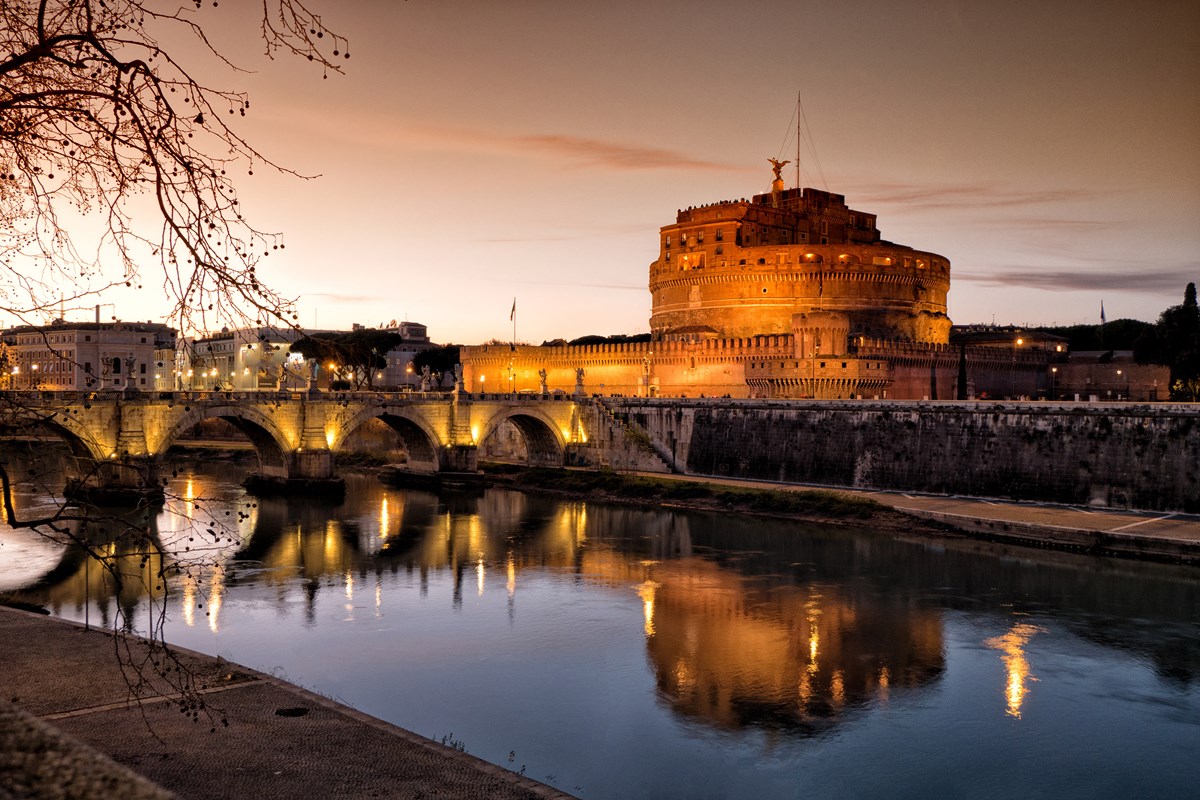
When it was a Prison
The castle wasn’t just a fortress, contented by many for the control over the city, but it was a place of detention for a great number of notable prisoners. There were basically two categories of cells: the obscure and dark ones obtained by adapting the ancient rooms of the basement, and some in the upper levels, usually assigned to high-status prisoners. Some of those prisons are open to visitors.
One of the most infamous cells was called San Marocco (or Sammalò). Originally, this cell was one of the air ducts of the ancient central room where the Imperial funeral urns were kept. Basically, it was a deep, dark hole with no windows, where the prisoner was lowered, and it was so narrow and low that he had no chance of standing or lying down.
During the centuries, among the people that were forced to spend some time locked up in the castle, there were more than one high rank clergymen, sometimes betrayed and killed by opponents, or even by other members of their own family.
The Count of Cagliostro, an obscure and self-proclaimed alchemist, but also famous scammer, was captured while hiding in an hotel on the Spanish Steps, and sentenced to life imprisonment. He spent the first three years of detention here.
In 1600, Giordano Bruno, accused of heresy, underwent, in the castle’s halls, the trial that condemned him to be burned at the stake in the square of Campo de’ Fiori (not far from Piazza Navona) where a statue of the philosopher still commemorates the event. Even the famous sculptor Benvenuto Cellini, the creator of art masterpieces, spent about one year in those cells.
But one of the creepiest events was the imprisonment of the young noblewoman Beatrice Cenci, who was accused of killing her abusing father and beheaded in 1599, at the age of 22. The execution stirred deep emotion among the population, who were against the pope’s decision, and her unfair execution made her a popular heroine, and symbol of the excessive power of the Vatican. The ghost of Beatrice is believed to appear every year, on September the 11th, walking back and forward on the bridge in front of the castle, holding her severed head in one hand. If you’d like to know more about the darkest secrets of Rome, you can have a look at our Ghost Walk Tour page.
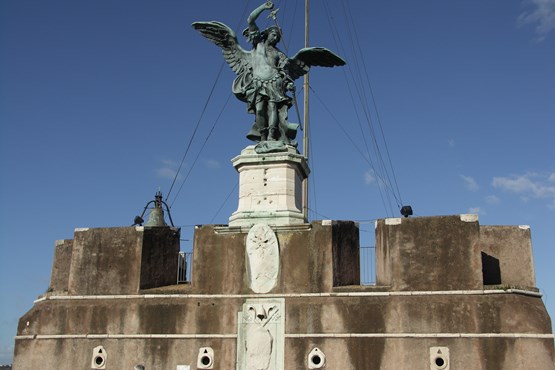
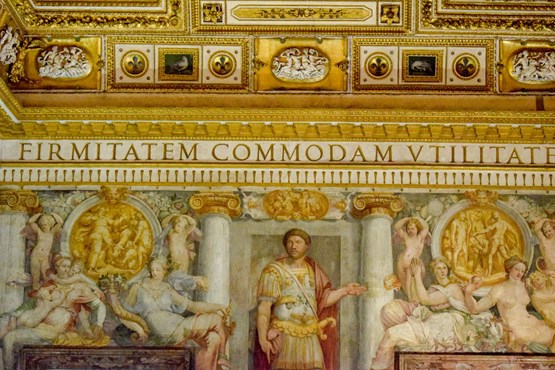
The French Army Siege and the End of the Papal State
When you walk into the castle, you’ll soon realize that there is a particular focus on old armaments, which are well represented both in the outside spaces and in the museum halls of the complex. During the Napoleonic era, the castle was occupied by the French army. Then, in 1849, the newly proclaimed Republic of Rome was besieged and then, again, occupied by the French. They took possession of the Sant’Angelo Castle, and, after extensively bombing the town center, returned the command of the city to the pope. This only lasted until the Italian army arrived to Rome in 1870, defeating the French and Swiss armies protecting the pope, and annexing Rome to the Italian Republic. The Italian army took control of the castle, and the government installed military headquarters there.
The Legend (and Ups and Downs) of the Angel
At the top of the castle, you’ll see a bronze statue of the Archangel Michael, who is “responsible” for the permanent name change of the monument, that was once a pagan tribute to the Roman emperors. However, the statue you see today was not the first one to sit at the top of Castel Sant’Angelo, but, actually, the sixth in line!
In the year 590 AD, during some of the darkest times of the city, a terrible plague struck the citizens. Pope Gregory organized a solemn procession to beg God to put an end to that nightmare. When crossing the bridge in front of the castle, the pope had a vision of the Archangel Michael in the act of sheathing his sword. This was interpreted as a sign that the plague would have soon come to an end.
To celebrate the event, the pope ordered a wooden statue of the angel be built, and this was the first one that sat at the top of the monument. When the statue was completely ruined by wear, it was replaced with a marble one, which was destroyed during a siege, in 1379. The third angel (again, made of marble, with bronze wings) was hit by a lightning strike. The fourth one, made of bronze covered in gold, was fused to make cannons. The fifth in line is a marble statue with bronze wings. Even this one was replaced, and now it’s located inside the castle’s courtyard.
So, after this troubled story, who is the angel which surmounts the castle today? It’s a bronze statue made in 1753 by a Flemish artist called Peter Anton von Vershaffelt. This angel was restored about 30 years ago, hoping it will have better luck than the previous ones!

The Castle Today
The site is now a museum, and features different itineraries:
- The outer walls, fortifications, passages and prisons.
- The basement with the visible ruins of the ancient Hadrian’s mausoleum.
- The papal apartments and halls.
- A vast collection of statues, paintings, artifacts, and a large armory featuring weapons and ancient armors.
- The terrace of the angel, where you’ll enjoy one of the most stunning views of the capital. Get your camera ready!
A visit to this site is fun and entertaining for the whole family. Under request, there is also an elevator available. You can visit the castle with a guide or on your own. It is recommended to book your tickets online.
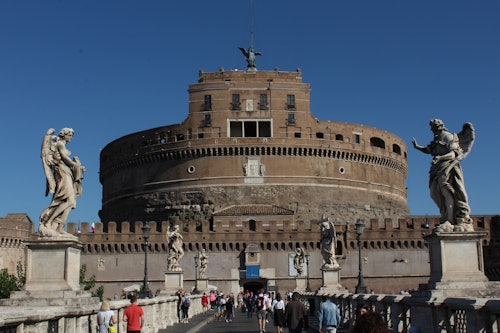
Castel Sant'Angelo: Fast Track & Guided Tour
Castel Sant'Angelo: Fast Track & Guided Tour
Enjoy a guided tour of Castel Sant’Angelo without having to wait in the long queue. This monument was previously the mausoleum of Emperor Hadrian, a Papal fortress and also a prison! Explore the halls, admire the splendid murals and learn about one of Rome’s most famous landmarks. From the top, you will see jaw dropping views of the Eternal City. The ticket includes priority entrance and a headset, so that you can always hear the guide.
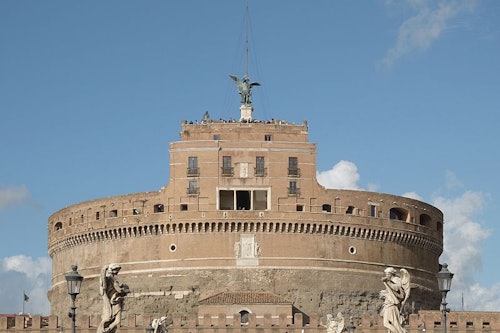
Castel Sant’Angelo: Fast Track
Castel Sant’Angelo: Fast Track
Castel Sant'Angelo has been used for many different purposes over the centuries. It was built as a Mausoleum, providing a final resting place for Emperor Hadrian and his family. After that, it has been a prison and defense fortress. Today it is a museum. Atop Castel Sant'Angelo is a statue of the Archangel Michael. Skip the queue by buying your tickets online in advance. The Angel Bridge connects the castle across the Tiber with the other side of Rome.
Castel Sant’Angelo in Popular Culture
This castle has been featured in countless movies, but the most famous one is probably Angels and Demons (Ron Howard, 2009) starring Tom Hanks. The site has been used for fashion shows as well as a location for many events.
The last act of the opera “Tosca” by Puccini is set in the castle, where the story wraps up in a tragic and spectacular way. The famous air “E lucevan le stelle”, is sung by one of the main characters (Mario Caravadossi) just before his execution, and his lover Tosca, grief-stricken, throws herself from the high castle’s walls. After 120 years since this opera premiered for the first time, we’re sure you’ll forgive us for the spoiler!
The Bridge of Angels
The bridge in front of the castle was built by Hadrian, to connect the mausoleum with the rest of the city, and it was originally called the Elian Bridge. Then, in 1535, the bridge was restored, and the pope had two statues erected at the entrance of the bridge, opposite the castle, depicting the saints Peter and Paul. One hundred years later, the statues of 10 angels, made by artists working under the direction of Bernini, were placed on the balustrades of the bridge.
How to Get to Castel Sant’Angelo and Travel Tips
You can include St. Angelo to your visit to St. Peter’s and the Vatican, as they are within walking distance. To get here, you can catch public transport (bus lines 23, 280, 40, 49, 62, 64 and 982) or simply catch the subway (Metro Linea A) and get off at the stop called Ottaviano.
If you are traveling with kids, they will be thrilled to visit this castle, which is full of passageways, hidden corners and ancient armors. At the top of the castle there is a panoramic cafeteria, where you can enjoy a coffee or a quick snack.
FAQ
What is Castel Sant'Angelo?
Castel Sant'Angelo was the Mausoleum of the emperor Hadrian and his family. Later the Sant'Angelo Castle was used as a defensive castle. Today it is a museum.
Where is Castel Sant'Angelo?
Castel Sant'Angelo is located close to St. Peter's Basilica along the Tiber River
What is the legend of Castel Sant'Angelo?
According to legend, during the plague, the Archangel Michael appeared to the Pope. The Pope begged the angel to put an end to the terrible disease. Archangel Michael answered his prayers. There is now a statue on the spot where Michael appeared.
Who built the Castel Sant'Angelo?
Castel Sant'Angelo was built as a Mausoleum for Emperor Hadrian 135 AD.
Does Castel Sant'Angelo belong to Vatican City?
No, Castel Sant'Angelo belongs to the Republic of Italy, and it's administered by the National Museum Dept of the Rome City Council.


